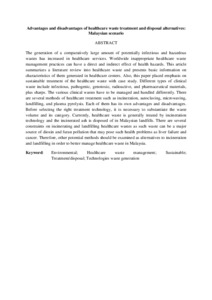Citation
Ghasemi, Maryam Khadem and Mohd Yusuff, Rosnah
(2016)
Advantages and disadvantages of healthcare waste treatment and disposal alternatives: Malaysian scenario.
Polish Journal of Environmental Studies, 25 (1).
pp. 17-25.
ISSN 1230-1485
Abstract
The generation of a comparatively large amount of potentially infectious and hazardous wastes has increased in healthcare services. Worldwide inappropriate healthcare waste management practices can have a direct and indirect effect of health hazards. This article summarizes a literature review into healthcare waste and presents basic information on characteristics of them generated in healthcare centers. Also, this paper placed emphasis on sustainable treatment of the healthcare waste with case study. Different types of clinical waste include infectious, pathogenic, genotoxic, radioactive, and pharmaceutical materials, plus sharps. The various clinical wastes have to be managed and handled differently. There are several methods of healthcare treatment such as incineration, autoclaving, microwaving, landfilling, and plasma pyrolysis. Each of them has its own advantages and disadvantages. Before selecting the right treatment technology, it is necessary to substantiate the waste volume and its category. Currently, healthcare waste is generally treated by incineration technology and the incinerated ash is disposed of in Malaysian landfills. There are several constraints on incinerating and landfilling healthcare wastes as such waste can be a major source of dioxin and furan pollution that may pose such health problems as liver failure and cancer. Therefore, other potential methods should be examined as alternatives to incineration and landfilling in order to better manage healthcare waste in Malaysia.
Download File
![[img]](http://psasir.upm.edu.my/54983/1.hassmallThumbnailVersion/Advantages%20and%20disadvantages%20of%20healthcare%20waste%20treatment%20and%20disposal%20alternatives.pdf)  Preview |
|
Text (Abstract)
Advantages and disadvantages of healthcare waste treatment and disposal alternatives.pdf
Download (5kB)
| Preview
|
|
Additional Metadata
Actions (login required)
 |
View Item |

